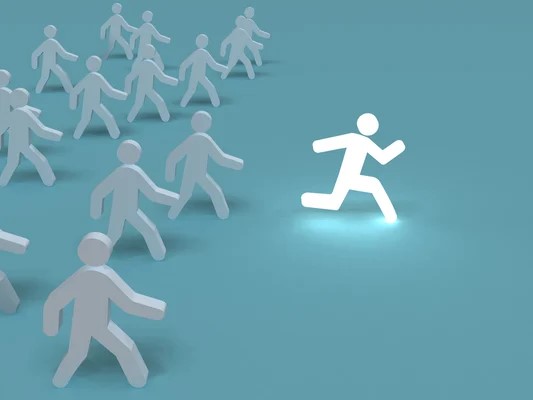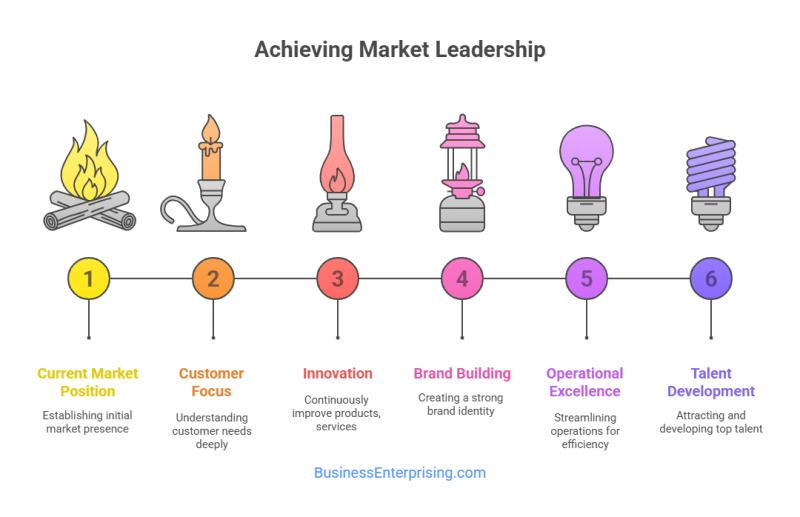
Additionally, you need to build systems that support long-term growth. That includes operations, communication, and decision-making processes. When these align, your team works better. Therefore, leadership becomes a shared goal rather than an individual task. However, alignment takes effort. You must revisit your goals often and keep your actions consistent with your message.
You also need to stay ahead of change. Markets shift quickly, and hesitation costs time. Therefore, make small adjustments early instead of large ones later. Additionally, listen closely to feedback from your team and customers. That input helps you stay grounded. However, not every suggestion needs action. Choose based on what supports your main goals.
Finally, remember that leadership reflects how you act when pressure rises. Do you maintain clarity and direction? Do others follow with confidence? If so, you’re on the right path. By focusing on people, process, and performance, you move closer to leading your market with strength and purpose.
Understanding Market Leadership
Market leadership refers to a company’s ability to dominate its industry or market segment in terms of market share, brand recognition, and influence. Market leaders set trends, influence consumer behavior, and often enjoy higher profitability and brand loyalty.
Understanding market leadership starts with clarity. It is not only about size. It is about influence, direction, and consistency. Market leaders set trends rather than follow them. They define standards that others must match or exceed. However, gaining that position requires more than being first to market.
You must offer value that others cannot replicate. That often means improving customer experience, strengthening your brand, and maintaining operational discipline. Additionally, it requires knowing your competitors well. Their weaknesses help you sharpen your strengths. Their moves help you test your own. Achieving market leadership depends on both awareness and execution.
Therefore, consistent innovation plays a key role. You need to keep improving your offer even when things are working. Markets shift quickly, and what worked last year might stall now. However, leadership is not only about innovation. It also demands reliability. Customers want to trust that your offer will work every time.
Additionally, your internal culture should support fast decision-making. That means giving your team tools and authority to act when needed. Many companies lose their edge by slowing down. However, when you maintain speed and clarity, you stay ahead. Therefore, build systems that allow fast pivots when needed.
Finally, remember that leadership must be earned daily. You cannot assume people will follow you just because they did yesterday. Therefore, keep listening, keep refining, and stay committed to progress. When you stay focused and consistent, your brand becomes the benchmark others chase. That is how leadership grows stronger over time.
Benefits of Market Leadership
Achieving market leadership brings clear advantages. It gives your company stronger pricing power and greater control over your market segment. Customers tend to trust market leaders more. That trust often leads to higher sales and better retention. Additionally, your marketing efforts become more effective as your reputation grows.
Because of your position, partners may approach you first. This opens the door to better deals and more strategic alliances. Therefore, you gain access to opportunities that others miss. You also attract top talent more easily. People want to work for companies that lead their field. However, that also raises expectations. You must continue to deliver value and stay ahead of trends.
Additionally, market leadership often leads to economies of scale. As volume increases, your unit costs go down. Therefore, you can invest more in product development or customer service. You gain flexibility to test new offers or expand your reach. However, those benefits require discipline and planning. Without focus, leadership can fade quickly.
Another benefit is influence. As a market leader, you shape customer preferences. You also influence how competitors respond. Therefore, your decisions can steer the entire market. That power must be used wisely. If you lose sight of your customer’s needs, others will fill the gap.
Finally, achieving market leadership builds long-term resilience. Your brand gains stability and momentum. That helps you weather downturns or unexpected shifts. While others react, you can lead. That difference makes your success more durable and repeatable.
Increased Market Share:
Market leaders without a doubt, capture a significant portion of the market, translating into higher sales and revenue.
Brand Recognition and Loyalty:
Additionally, market leaders are often top-of-mind for consumers, leading to strong brand recognition as well as loyalty.
Pricing Power:
With a dominant market position, leaders can often command premium pricing for their products or services.
Attracting Top Talent:
Market-leading companies also attract top talent who seek to work with industry pioneers.
Innovation and Influence:
Market leaders are typically seen as innovators and trendsetters, giving them the ability to shape industry standards and practices.
Strategies for Achieving Market Leadership
Achieving market leadership requires more than ambition. You need clear direction, repeatable processes, and a commitment to continuous improvement. However, it starts with knowing your customer better than anyone else. That knowledge lets you build offers people value and remember. Additionally, it helps you avoid chasing trends that do not align with your core business.
Therefore, focus on solving real problems. If your product delivers results consistently, your reputation will grow. Customers talk about what works. Additionally, you must keep improving your offer. Do not assume current success guarantees future demand. Markets shift quickly. However, companies that adapt well stay ahead.
You also need a strong brand identity. That means clarity in your message and consistency across all channels. Therefore, train your team to speak with one voice. When your brand feels aligned, customers trust you more. Additionally, invest in marketing that reaches the right people at the right time. Random promotions may create attention, but they rarely build loyalty.
Operational strength matters as well. Therefore, build systems that support efficiency and quality. That lets you scale without losing focus. Additionally, it frees up resources for growth. However, leadership also depends on how you respond to competition. Watch your competitors but do not copy them. Lead with purpose, not reaction.
Finally, keep your team engaged and informed. When everyone understands the mission, performance improves. Culture supports execution. That foundation helps you stay sharp, agile, and focused on achieving market leadership.
Innovate Continuously:
Innovation is at the heart of market leadership. With this in mind, companies must continuously develop new products, services, and business models to stay ahead of competitors. Invest in research and development (R&D) to foster a culture of innovation and ensure a steady pipeline of breakthrough ideas.
Focus on Customer Experience:
Delivering exceptional customer experiences is crucial for building brand loyalty and gaining a competitive edge. Understand your customers’ needs, preferences, and pain points, and tailor your offerings accordingly. Provide personalized, seamless, and memorable interactions across all touchpoints.
Build a Strong Brand Identity:
A strong brand identity differentiates a company from its competitors. Develop a clear and compelling brand message that resonates with your target audience. Consistent branding across all channels enhances recognition and builds trust.
Leverage Data and Analytics:
Data-driven decision-making is essential for market leadership. Utilize advanced analytics to gain insights into customer behavior, market trends, and operational efficiencies. Data can inform strategic decisions, optimize marketing campaigns, and improve customer targeting.
Expand Market Reach:
Explore opportunities to expand your market reach. This could involve entering new geographic markets, targeting different customer segments, or diversifying your product or service offerings. Market expansion strategies should be supported by thorough market research and analysis.
Invest in Talent Development:
Attracting, retaining, and developing top talent is vital for maintaining market leadership. Create a supportive and inspiring work environment that fosters creativity and innovation. Offer continuous learning and development opportunities to enhance employees’ skills and capabilities.
Leadership Pro Tips
Strong leadership requires more than giving orders. It means showing consistency, listening well, and setting clear expectations. However, consistency does not mean rigidity. You need to respond to change without losing focus. Therefore, stay flexible but firm. Your team will follow your actions more than your words.
Additionally, communication must be direct and frequent. When people feel informed, they stay engaged. Therefore, share goals, progress, and challenges often. However, don’t talk just to talk. Keep your messages simple and timely. Also, listen more than you speak. That helps you make better decisions and catch small issues early.
You must also model the behaviors you expect. That includes punctuality, accountability, and respect. Therefore, check yourself first before correcting others. When people see fairness, they respond with effort. Additionally, reward initiative. That encourages a proactive mindset that leads to steady progress.
However, leadership is not about being right all the time. It’s about getting results through others. Therefore, build a team you trust and allow them room to grow. Let your confidence in them show. When people feel trusted, they take ownership.
Finally, remember that great leadership supports great outcomes. Achieving market leadership often reflects internal strength first. If your team functions well, your brand becomes stronger. Therefore, invest in people and process equally. When you lead with clarity and purpose, others follow naturally.
Enhance Operational Efficiency:
Operational efficiency can provide a competitive advantage by reducing costs and improving profitability. Implement lean practices, automate processes, and leverage technology to streamline operations. Efficient operations also enable faster response to market changes and customer demands.
Engage in Strategic Partnerships:
Form strategic partnerships and alliances to enhance capabilities and expand market presence. Collaborations with other businesses, industry associations, or technology providers can open new opportunities and accelerate growth.
Prioritize Corporate Social Responsibility (CSR):
Today’s consumers are increasingly concerned about the social and environmental impact of the businesses they support. Demonstrating a commitment to CSR can enhance brand reputation and loyalty. Engage in sustainable practices, support community initiatives, and communicate your CSR efforts transparently.
Monitor Competitors and Market Trends:
Stay vigilant about competitor activities and market trends. Regularly conduct competitive analysis to identify threats and opportunities. Being proactive as well as adaptive allows market leaders to stay ahead of industry changes and emerging competitors.
Conclusion
Leadership does not rely on title or status. It depends on your ability to act, adapt, and influence others with purpose. However, strong leadership only lasts when backed by discipline. Therefore, you must stay focused even when results slow or conditions shift.
Additionally, leadership demands patience. You will not see change overnight. Progress builds through daily actions and steady improvements. Therefore, track what matters and stay consistent. However, do not mistake activity for progress. Choose actions that move the business forward. That focus builds confidence in your direction.
You also need to support others as they grow. A strong team reflects the leader behind it. Therefore, spend time developing people, not just tasks. When your team succeeds, your influence multiplies. Additionally, small wins often lead to bigger gains. Celebrate progress without losing sight of long-term goals.
Achieving market leadership takes more than ambition. It takes clear goals, steady habits, and the courage to lead when others hesitate. However, it also means staying humble. You will not have every answer. Therefore, listen, adjust, and keep improving. That mindset creates lasting value. Finally, leadership is not a final step. It is a habit. When you lead with clarity and action, you create lasting results. Therefore, keep leading with purpose, and the rest will follow.


